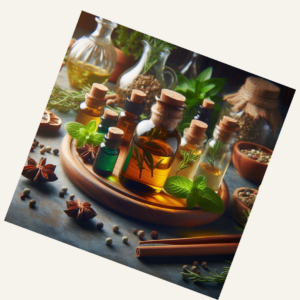Your cart is currently empty!
Spagyric tinctures are a specific type of herbal extract produced through the ancient alchemical process of spagyria. The term “spagyric” comes from the Greek words “spao” (to separate) and “ageiro” (to unite), reflecting the process of separating and then recombining the plant’s energetic, physical, and spiritual components. This process is deeply rooted in alchemy and is designed to extract and preserve the full range of the plant’s properties—physical, energetic, and spiritual—by working with its essential oils, herbs, CO2 extractions, and ash.
In spagyric tinctures, the plant material is carefully processed in a way that ensures the full spectrum of its beneficial properties is captured. Unlike conventional tinctures, spagyric tinctures include both the volatile oils (the essential oils) and the fixed salts from the plant, which are extracted and reintroduced after purification. These tinctures are known for their higher potency, holistic healing properties, and unique energetic qualities.
Key Components of Spagyric Tinctures:
- Essential Oils:
- Essential oils are highly aromatic compounds that contain the plant’s volatile oils. These oils carry the plant’s vibrational energy and therapeutic properties.
- In spagyria, essential oils are separated from the plant and later recombined after the other components (such as salts and fixed oils) are processed. These oils are considered the plant’s spiritual essence, as they embody the plant’s life force and energy.
- CO2 Extractions:
-
- CO2 extraction is a method of extracting essential oils from plant material using carbon dioxide under high pressure and low temperatures. This method preserves the plant’s delicate compounds, which can sometimes be lost in traditional distillation processes.
- CO2 extractions capture a broader range of compounds, including those that are too delicate for steam distillation. These extracts provide a fuller spectrum of the plant’s active constituents.
- Herbs:
-
- The herbs themselves are the foundational material from which the spagyric tincture is made. The plant material is usually dried and finely ground to facilitate the extraction of the active compounds.
- In spagyric alchemy, the herbs are considered to carry both physical and spiritual qualities that support healing on multiple levels—body, mind, and spirit.
- Ash:
-
- The ash is obtained by burning the plant material after the extraction of essential oils and other components. This ash contains the fixed salts of the plant, which represent the earthly or material aspect of the plant.
- These salts are purified and then reintroduced to the tincture. The reintroduction of ash brings the plant back into balance, harmonizing its earthly and spiritual properties, and is believed to enhance the tincture’s healing potential.
The Spagyric Process:
- Separation:
- The first step involves separating the plant’s essential oils, salts, and fixed compounds. This typically involves distillation (to extract essential oils), fermentation, and burning (to produce ash).
- Purification:
-
- Each component (essential oils, salts, and plant material) is then purified through various alchemical processes. For example, the ash is purified to remove any impurities, while the essential oils are filtered and processed to retain their potency.
- Recombination:
-
- After the individual components are purified, they are recombined to create the spagyric tincture. This is the crucial alchemical step where the plant’s physical, energetic, and spiritual properties are harmonized, and the tincture is imbued with its full range of therapeutic potential.
How to Use Spagyric Tinctures:
- General Dosage:
- Typically, spagyric tinctures are used 1-3 times per day. A standard dosage is usually 1-2 dropperfuls(around 20-30 drops) mixed with water, tea, or juice.
- Start with a lower dose and gradually increase as needed, observing the body’s response.
- Energetic Healing:
-
- Spagyric tinctures are not only for physical health; they also support energetic and spiritual healing. The tincture can be used in rituals, meditation, or energy work to balance and harmonize the body’s energy fields.
- Some people use them in ritual baths, aromatherapy (spraying in the environment), or topical applications(like anointing specific areas of the body or using in massage oils) to amplify their energetic benefits.
- Spagyric tinctures can be used alongside other herbal or holistic remedies to enhance their effectiveness. Their powerful energetic and medicinal properties make them particularly useful when combined with other forms of healing, such as energy healing, aromatherapy, or acupuncture.
Example of Spagyric Tincture Use:
Let’s say you are using a spagyric tincture of chamomile for relaxation:
- Preparation: You take 1-2 dropperfuls of chamomile spagyric tincture in water once or twice a day.
- Energetic Purpose: During stressful moments, you may place a few drops of the tincture on your palms, rub them together, and inhale the scent. This allows you to experience the calming effects of chamomile not just physically, but energetically as well.
- Holistic Healing: In combination with other practices, such as breathing exercises, you can amplify the spiritual relaxation and balance achieved through the chamomile tincture.
Caution and Considerations:
- Herb Sensitivity: Since spagyric tinctures are concentrated, they may cause reactions if you’re sensitive to the herb used. Always consult a healthcare professional before starting any new herbal regimen, particularly if you have health conditions, are pregnant, or are on medication.
- Alcohol Content: Many spagyric tinctures use alcohol as a base, so be mindful of the alcohol content if you have concerns about alcohol consumption.
- Proper Dosage: Because these tinctures are potent, it’s important to follow recommended dosages and start with a lower amount to assess your body’s response.
Spagyric Tincture is one of the many methods of using essential oils.
Available in:
Spagyric Blue Lotus Tincture 1oz
Spagyric Frankincense Tincture 1oz
Spagyric Frankincense Body Tonic 4oz
